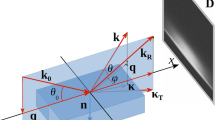Abstract
As a Gaussian beam is incident upon a rough surface at low grazing angle, the Helmholts scalar wave equation may be replaced by the parabolic approximate equation. As the incident field is known, the scattered field and surface current give the Volterra integral equation. Surface roughness profile can be formulated by the integral equation of the surface currents. These two coupled equations are applied to invert the roughness profile of heterogeneous fractal surface. Using Monte Carlo method, the fractal rough surfaces with a band-limited Weistrass-Manderbrot function are numerically simulated and the scattered fields along a line parallel to the mean surface are solved. The Gaussian beam incidence and scattered fields are used to progressively invert the surface roughness profile. Reconstructed profile and its inverted fractal dimension, roughness variance and correlation length are well matched with the simulated surfaces.
Similar content being viewed by others
References
A. Roger, D. Maystre, Inverse scattering method in electromagnetic optics: Application to diffraction gratings, J. Opt. Soc. Am., 70(1980)7, 1483–1495.
A. M. Husier, A. Quatropani, H. D. Baltes, Construction of grating profiles yielding prescribed diffraction efficiencies, Opt. Commun., 41(1982)2, 149–153.
R. J. Wombel, J. A. DeSanto, The reconstruction of shallow rough surface profiles from scattered field data, Inverse Probl., 7(1991)L, 7–12.
R. J. Wombel, J. A. DeSanto, Reconstruction of rough surface profiles with the Kirchhoff approximation, J. Opt. Soc. Am. A, 8(1991)12, 1892–1897.
M. Spivack, Direct solution of the inverse problem for rough surface scattering at grazing incidence, J. Phys. A: Math. Gen., 25(1992)10, 3295–3302.
M. Spivack, A numerical approach to rough surface scattering by the parabolic equation method, J. Acoust. Soc. Am., 87(1990)5, 1999–2004.
M. Spivack, Solution of the inverse scattering problem for grazing incidence upon a rough surface, J. Opt. Soc. Am. A, 9(1992)8, 1352–1355.
D. L. Jaggard, X. Sun, Fractal surface scattering: A generalized Rayleigh solution, J. Appl. Phys., 68(1990)11, 5456–5462.
T. C. Le., Y. Kuga, A. Ishimaru, Angular correlation function based on the second order Kirchhoff approximation and comparison with experiments, J. Opt. Soc. Am. A, 13(1996)5, 1057–1067.
Y. Q. Jin, G. Li, Detection of a scatter target over randomly rough surface by using angular correlation function in finite element approach, Waves in Random Media, 10(2000)6, in press.
M. Spivack, Moments of wave scattering by a rough surface, J. Acoust. Soc. Am., 88(1990)5, 2361–2366.
S. Rourier, P. Borderies, Ultra wide band electromagnetic scattering of a fractal profile, Radio Science, 32(1997)2, 285–293.
Y. Lo, H. Leung, S. Haykin, Fractal characterization of sea-scattered signals and detection of sea surface targets, IEE Proc.-F, 140(1993)4, 243–250.
Author information
Authors and Affiliations
Additional information
Supported by the National Natural Science Foundation of China (N0: 49831060, 69771007) and National 863-818-06-05
About this article
Cite this article
Jin, Y., Li, Z. Inversion of roughness profile of heterogeneous fractal surface using Gaussian beam incidence at low grazing angle. J. of Electron.(China) 18, 289–296 (2001). https://doi.org/10.1007/s11767-001-0042-3
Issue Date:
DOI: https://doi.org/10.1007/s11767-001-0042-3



